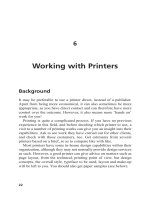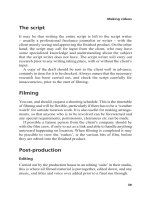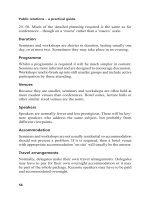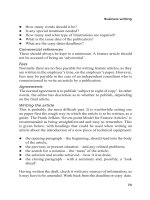Online Public Relations A Practical Guide to Developing an Online Strategy in the World of Social Media PR in Practice_12 doc
Bạn đang xem bản rút gọn của tài liệu. Xem và tải ngay bản đầy đủ của tài liệu tại đây (574.19 KB, 20 trang )
274 Pursuing Excellence in Healthcare
ese researchers suggest that using fewer hospital beds, less physician labor,
and fewer high-tech treatments (such as intensive care beds and expensive imag-
ing devices) could markedly decrease costs. Not surprisingly, they also found
that integrated group practices, in which all physicians and the accompany-
ing hospital are integrated into a single practice group and physicians’ salaries
are based on their areas of specialization, are associated with the use of fewer
resources [27].
Although the results of the Dartmouth study are intriguing, they raise as
many questions as they answer. For example, how did the small class size of
the medical school at the Mayo Clinic, demographics of its patient population,
reimbursement structures for physicians, and the local malpractice environment
influence physician behavior and resource utilization? e most important mes-
sage to come from the Dartmouth study was [27]
e nation needs a crash program to transform the management of
chronic illness to a rational system where what happens to patients
is based primarily on illness severity, medical evidence, and the
patient’s wishes, and where resource allocation and Medicare spend-
ing can be guided more and more by knowledge of what is needed
to produce cost-effective, high-quality care. e support of such
research needs to be the responsibility primarily of federal science
policy. It makes no sense for the government to invest in biomedical
research…without complementary research aimed at determining
how new and existing treatments affect the outcomes of care, the
lives of patients, and the efficacy of clinical practice.
us, government must support new and innovative research studies; in par-
ticular, those that do not fall under the traditional portfolio of the National
Institutes of Health could be considered under the mandate of clinical and
translational research. Lobbying Congress for the support of innovative new
research in healthcare policy by collaborative groups of scholars from both busi-
ness schools and AMCs might be one of the tasks of the national commission.
Building Infrastructure for the AMC
In order to stem the evaporating jobs and deepening recession, President-elect
Obama promised to expand the opportunities for Americans to work by under-
taking massive public works projects to improve the country’s infrastructure.
Projects would include repairing or rebuilding aging roads, schools, sewer
systems, mass transit facilities, dams, and electrical grids—as well as creating
Ensuring Governmental Support and Oversight of the AMC 275
alternative fuels, building windmills and solar panels, and replacing existing
environmental systems with fuel-efficient heating or cooling systems.
Investing in the infrastructure of AMCs could also provide broad local and
global economic opportunities. Many institutions have had to defer capital
improvements to aging research and clinical facilities; others are struggling to
support the debt service on buildings planned and built during the NIH “boom
years” between 1997 and 2003, when the NIH budget doubled. In addition,
individual investigators and collaborative groups have often been forced to make
do with old and outdated laboratory equipment because of marked cutbacks in
their NIH funding. At many AMCs clinical facilities are also in need of repair
and capital is required to replace aging or outdated equipment —infrastructure
support that can improve care, lower costs, and support the economic health of
the community.
Perhaps the most important research “infrastructure” needed is talented
young physicians and physician–scientists. At a time when most medical stu-
dents graduate with six-figure debt, tuition reimbursement programs for indi-
viduals who pursue careers in the clinical and translational sciences would be
one means of providing a bulwark against the continuing attrition of talented
physicians and physician–scientists.
References
1. Mayo, W. Rush Medical College commencement, June 15, 1910. 2000. Mayo
Clinic Proceedings 75:553–556.
2. /> 3. Myers, M. 1987. When hospital doctors labor to exhaustion. New York Times, June
12.
4. Colburn, D. 1988. Medical education: Time for reform? After a patient’s death, the
36-hour shift gets new scrutiny. Washington Post, Mar. 29.
5. Japenga, A. 1988. Endless days and sleepless nights: Do long work schedules help
or hinder medical residents? LA Times, Mar. 6.
6. Segal, M. M., and Cohen, B. 1987. Hospital’s junior doctors need senior backup.
New York Times, June 8.
7. Sullivan, R. 1987. Grand jury assails hospital in ‘84 death of 18-year-old. New York
Times, Jan. 13.
8. Daley, S. 1988. Hospital interns’ long hours to be reduced. New York Times, June
10.
9. Horwitz, L. I., Kosiborod, M., Lin, Z., and Krumholz, H. M. 2007. Changes in
outcomes for internal medicine inpatients after work-hour regulations. Annals of
Internal Medicine 147 (2): 97–103.
276 Pursuing Excellence in Healthcare
10. Volpp, K. G., Rosen, A. K., Rosenbaum, P. R., Romano, P. S., Even-Shoshan, O.,
Wang, Y., Bellini, L., Behringer, T., and Silber, J. H. 2007. Mortality among hospi-
talized Medicare beneficiaries in the first 2 years following ACGME resident duty
hour reform. Journal of the American Medical Association 298 (9): 975–983.
11. Meier, M. 2008. Senators question financial ties between doctors and steel manu-
facturers. New York Times, Oct. 17.
12. Berenson, A. 2008. Weak oversight lets bad hospitals stay open. New York Times, Dec.
8.
13. AAMC. 2004. Project Apacsor—What Americans say about the nation’s medi-
cal schools and teaching hospitals, 1–36. Public and congressional staff opinion
research project.
14. www.acc.org
15. /> 16. Fuchs, E. 2008. Budget battles could last into 2009. AAMC Reporter 17 (6): 1.
17. www.aamc.org
18. /> 19. /> 20. Mamula, K. 2008. UPMC outspends all U.S. hospitals on lobbying. Pittsburgh
Business Times, Aug. 8.
21. Toland, B. 2008. Insurers spending millions on lobbying. Pittsburgh Post-Gazette,
Sept. 7.
22. Flexner, A. 1973. Medical education in the United States and Canada: A report to
the Carnegie Foundation for the Advancement of Teaching, 346. Bulletin no. 4,
New York (reprinted by e Heritage Press, Buffalo, NY).
23. Disraeli, B. 1877. Speech, Battersea Park. London Times, 10.
24. Krasner, J. 2008. State urged to review fees to elite hospitals. e Boston Globe, Nov.
20.
25. Kirch, D. e tough questions (www.aamc.org).
26. Cohen, B. 2008. Harvard Medical School to reduce student debt burden
( /> 27. Wennberg, J. E., Fisher, E., Goodman, D. C., and Skinner, J. S. 2008. Tracking
the care of patients with severe chronic illness. e Dartmouth Atlas of Healthcare,
Dartmouth Institute of Health Policy and Clinical Practice, Lebanon, NH.
277
Conclusion
As clearly demonstrated in the preceding chapters, there is little doubt that
academic medical centers are threatened by a vast combination of factors,
including
intense marketplace competition from private hospitals;
decreased reimbursements from third-party payers;
a change in the demographics of the medical student population;
increasing regulation from authoritative bodies governing requirements for
undergraduate and graduate education programs;
a shift of clinical research opportunities from the pubic to the private sector
as well as from the United States to Europe, Asia, and South America;
the steadily increasing cost of a medical school education;
draconian cuts in the NIH budget;
the global economic crisis; and
a general malaise among members of the academic faculty.
Although academic medical centers must begin to change in order to meet
these many challenges, the philosophic structure around which change should
occur has not been addressed since the publication of Flexner’s report in 1910.
e goal of this book was to bring to public attention the great challenges faced
by AMCs in fulfilling their societal responsibilities and to develop a new model
that would allow academicians to have an initial construct around which to base
their strategic plans.
Before beginning my research for this book, my impressions of what the
AMC of the future would look like rested on a group of assumptions that were
based largely on my own experiences. For example, I believed that the difference
between a good and a great AMC was that the great AMC had a core focus on
the “business of medicine” and that this helped to drive decision making as well
as investments of time and money. e second assumption was that a medical
278 Conclusion
school that did not have a substantial endowment and did not share positive
margins with its affiliated hospital would probably be better off focusing on
education and clinical care rather than struggling to support a research program;
this was consistent with how businesses commonly focus only on what they do
best. I also theorized that the separation of a hospital and its medical school
would allow the physicians to leverage their autonomy and independence.
Finally, I assumed that individual AMCs would have the best chance of survival
if they could compete effectively in their local healthcare markets. Interestingly,
my subsequent research led me to the realization that each of these initial
assumptions was flawed.
For example, I found that good business practices were a necessary part
of a successful AMC but were not sufficient to make the AMC great. Indeed,
making decisions based on “business” rather than basing each decision on what
would be best for achieving excellence in patient care could lead an institution
to renege on its societal responsibility. Without a core focus on providing
outstanding patient care, no AMC could effectively compete in the future
healthcare market or successfully teach the next generation of clinicians. I also
found that research was a critical component of all medical centers, regardless of
whether their goal was to train community physicians or clinician scientists. In
conversations with residents, postgraduate trainees, and students, I found that
those who had participated in research as medical students or between college
and medical school were more adept at critically reviewing clinical trials in the
literature, better able to think through complex cases, and far more likely to
pursue careers in academic medicine. is information not only had an effect
on the construction of the model presented in this book but also resulted in our
developing a resident research program to improve the educational experiences
in our department.
I also found that the most successful AMCs were not composed of
economically and administratively separate units but rather were closely linked
by an integrated structure. Finally, in contrast with my original belief that AMCs
should focus on their regional environments, I found that outstanding AMCs
today must develop regional as well as national collaborations and affiliations
in order to provide the best possible care for patients. us, although each
of the elements of structure, research, education, and business was necessary
to support the success of an AMC, none was sufficient in and of itself for
an institution to achieve greatness. Only when these elements contributed
synergistically to create an environment of outstanding patient care did an
individual AMC excel.
Each of the four spheres that constitute the supporting structure of this
book contains three chapters. ese 12 chapters present recommendations for
Conclusion 279
facilitating the ability of an AMC to attain excellence in patient care. ey can
be summarized as follows.
Sphere of Action I: Structure ◾
Chapter 1: Integrate the elements of the AMC, including the hospital,
the medical school, and the university, in order to align missions and
facilitate funds flow.
Chapter 2: Integrate clinical care delivery systems to ensure seamless com-
munication between caregivers and care integrated across the many
specialties that must be brought together in the treatment of a particu-
lar disease to provide outstanding patient care.
Chapter 3: Develop leaders who can utilize lessons learned from industry,
who can focus on preparing their successors, who are empowered to
effect change, and who have the stability that allows them to make
courageous decisions.
Sphere of Action II: Research ◾
Chapter 4: Recognize that research is necessary for clinical excellence.
Develop mechanisms for the health system and the hospital to sup-
port the research mission, enhance the development of translational
research, allocate funds appropriately to ensure alignment between
the clinical and research programs, and provide the necessary infra-
structure to facilitate the ability of the AMC to recapture clinical
research.
Chapter 5: Resolve conflicts of interest in order to regain the public trust in
AMCs and their faculty by developing rules that are fair, enforceable,
and provide the needed level of confidence and trust for the patient.
Chapter 6: Effectively commercialize research discoveries by providing an
infrastructure that supports the ability of investigators to take their
discoveries from the bench to the bedside.
Sphere of Action III: Education ◾
Chapter 7: Resolve the physician workforce crisis by creating a national
task force that can provide recommendations and guidance regarding
the development of programs in elementary and secondary schools.
ese programs will encourage students to pursue careers in healthcare,
address the serious issues of indebtedness, enhance public awareness of
the looming crisis, and ensure that all schools meet the appropriate
standards for producing outstanding clinicians.
Chapter 8: Address the changing demographics of America’s doctors by
decreasing the debt of academic physicians, making academic medi-
cine more attractive, creating a culture in the AMC that recognizes
280 Conclusion
the diverse needs and goals of women physicians, and enhancing the
diversity of the AMC.
Chapter 9: Teach medical professionalism in the AMC by educating
AMC leaders about how to deal with difficult issues of breaches in
professionalism, developing metrics to assess the quality of care and
professionalism of hospitals and individual caregivers, eliminating
the “hidden curriculum” in AMCs by ensuring consistency between
what is taught and what is practiced, and developing multidisciplinary
teams to evaluate professionalism.
Sphere of Action IV: Business ◾
Chapter 10: Develop innovative ways to finance the various missions of
the AMC, including documenting the ability to deliver outstanding
clinical care, developing a rational system for allocating funds, cre-
ating a national financial data bank that is available to investigators
to facilitate systems analysis, and improving hospital efficiency and
capacity.
Chapter 11: Expand the influence of the AMC and create novel new mar-
kets by undertaking global initiatives to provide outstanding care to
the world’s populations, developing novel collaborations in healthcare
delivery that cross state boundaries, and establishing partnerships
within local markets to improve care.
Chapter 12: Help federal agencies and Congress to recognize the need for
AMCs and the federal government to collaborate in improving the
health of the population while decreasing costs. is can be accom-
plished by establishing a national commission to oversee AMCs, estab-
lishing national guidelines for AMC financial reporting, developing a
reimbursement system that is consistent from state to state, evaluating
the plight of “safety-net” hospitals, working together to ensure con-
sistency in medical education and healthcare across all AMCs, and
convincing Congress that future improvements in America’s health-
care depend on supporting research initiatives to better understand
the delivery and economics of healthcare in the AMC.
Each of the chapters of this book presented recommendations that an AMC
should consider in developing a mission of providing excellence in patient care.
However, it is important for the reader to recognize that not every AMC needs
to or can pursue every recommendation. e financial capabilities, geographic
locale, and patient demographics will differ for each AMC, as will the level of
competition that it faces from other AMCs and from community hospitals. ese
differences will dictate where an individual AMC will allocate its resources.
Conclusion 281
For example, some AMCs may already have excellence in each clinical area, a
robust endowment, and a substantial hospital margin that allow them to provide
free tuition for their students and to focus on global rather than local collaborations.
By contrast, other AMCs may simply be unable to support excellence in all of
their clinical missions and will need to collaborate actively within their regions
to achieve their goals more effectively. However, many of the recommendations
are relevant to virtually all AMCs, such as a need to train tomorrow’s physicians
and physician leaders, integrate care delivery systems, resolve conflicts of interest,
address the changing demographics of the AMC workforce, enhance AMC
diversity, and lobby governmental agencies for additional research support.
Regardless of size or geography, however, an AMC can only fulfill its societal
mission if it focuses on the core mission of pursing excellence in patient care. is
core mission can most effectively be attained through the cohesive interaction
of the four supporting spheres: an integrated structure, a research enterprise, an
educational mission focused on training today’s and tomorrow’s physicians, and
a business-like approach to finance and administration.
Some of the recommendations provided might be viewed as quite radical. For
example, moving to a service line environment might be contrary to the culture
of many institutions—in particular, where the political and administrative power
of department chairs is great. For many hospital administrators and deans, the
thought that funds-flow information would be readily available to department
chairs and division chiefs might also be unacceptable. Furthermore, the concept
that competing AMCs could enhance their ability to fulfill their missions by
merging or affiliating might be perceived as radical—particularly because so
many high-profile mergers have failed. Indeed, a core focus on outstanding
patient care is in and of itself radical because most AMCs still promote their
tripartite missions of research, education, and clinical care. However, each of
these proposals has been shown to improve the ability of some AMCs to improve
patient care.
As importantly, at a time when many AMCs are struggling to compete in the
increasingly competitive healthcare marketplace and many are adversely affected
by the crisis in America’s financial markets, it is time for AMCs to begin to take
radical steps. As in a business, each of these steps should not be perceived as final.
Rather, it will be important to define metrics that can be utilized to judge the
success of each change on an ongoing basis so that AMC leaders can continually
reevaluate the outcomes and pursue modifications or changes in the paradigm
when the data do not confirm that the change has achieved its goals. Hopefully,
these suggestions for change—both radical and obvious—will provide a platform
for all members of the AMC to question their approach, discuss the issues, and
initiate change when these introspections identify areas in which patient care can
be improved.
282 Conclusion
For some AMCs, change is not easy. In an environment in which “culture
eats strategy,” the ability to modify or change decades-old paradigms is never
easy. us, AMC leaders should call on the expertise of professionals in the areas
of business, economics, and healthcare finance and change strategies to facilitate
achieving the new goals for the institution. AMCs affiliated with schools of
business can draw on expertise from individuals and programs located on their
campuses. For AMCs that do not have access to a business school, numerous
companies and consultants can provide help and training in developing teams,
effecting change, analyzing processes, creating metrics, and allocating resources.
AMCs should use consultants in two ways: (1) to help in executing change, and
(2) to train individual AMC members from all levels of management as agents of
change so that future initiatives can be led internally.
Although the stresses placed on today’s AMCs by the current healthcare
environment are unprecedented in size and scope, AMCs have met great
challenges over the past century: the Great Depression of the early 1930’s, two
World Wars that drew many of the finest physician groups from major AMCs
to the battle fronts in Europe and the Pacific, the entrance of managed care
three decades ago, and the current catastrophic collapse of the financial market.
Nevertheless, AMCs have stepped forward and continued to assure that their
patients were cared for, that students and graduates were trained, and that new
forms of care continued to be developed.
Clearly, AMCs will respond to the current challenges with the same level
of innovation, commitment, and energy with which they solved earlier crises.
is text can be helpful in educating physicians, academicians, policy analysts,
healthcare economists, and federal and state authorities and regulators regarding
the challenges faced by today’s AMCs. e fundamental message of the book is
that, by pursuing excellence, we can preserve America’s academic medical centers
and see to it that Americans of all ethnic, racial, and socioeconomic backgrounds
will be able to count on AMCs to provide them with the best possible care.
283
Index
5-year rule, 46–47
A
AAMC. See Association of American Medical
Colleges (AAMC)
Academic laboratories, as incubators, 118
Academic medical center(s)
boards, 60
collaborations, 246–253
in local marketplace, 243–245
regional, 240–241
commercializing technology, 119–121
culture of silence, 183–185
development of national markets,
242–243
diversity in, 164–165, 172
finances during capital market crisis,
220–221, 224–229
financial health, evaluation of, 205–206
funds, 206–220 (See also Academic
medical center(s), revenue sources)
allocation of, 226–227
gender demographics, 162–164
government oversight, 261
healthcare data bank, 227–228
hidden curriculum, 180, 196–197
historical perspectives, 3
industry and, 101–102
history of, 110–112
sponsored clinical trials, 75
integration, 26–31
examples of vertical and lateral, 28–29
new model for, 29–31
recommendations for, 34–38
types of, 26–27
leadership
around the edges, 51–61
challenges facing, 42–46
cultural impediments to effective,
47–48
empowerment of, 54–57
qualifications for, 52–53
redefining, 53–61
service line and, 36–37
structural impediments to effective,
49–50
training for, 57–59
legal environment, 180–182
lifestyle changes in, 165–166
local marketplaces and, 243–245, 247–253
mergers, 248
partnering opportunities in local
marketplaces, 247–253
research in, 68–69 (See also Research)
demise of clinical, 74–77
funding for, 68, 81–82
historical perspective, 68–69
strengthening, 77–79
revenue sources, 206–220
converting new discoveries to new,
112–118
endowments and fundraising activities,
218–219
entrepreneurial activities, 219–220
federal disproportionate share
payments, 212–213
federal support for medical education,
216–218
federal support for research, 213–214
hospital/health system support to
medical school, 214
284 Index
reimbursements for clinical care,
207–212
from state and local entities, 214–216
role in solving U.S. healthcare workforce
crisis, 142–150
structure
challenges of, 16
controversy regarding, 8–11
evolution of, 4–6
examples of successful, 11–15
organizational possibilities of, 7
patient care and, 23–24
recommendation for integration of,
16–18
silo, 182–183
staff models and, 15–16
types of, 6–8
student body, demographics of, 156–158
women physicians, 170–172
Academic medicine, 168–170
Albert Einstein School of Medicine, 156
Allegheny Health, Education, and Research
Foundation (AHERF), 13, 204,
241
Applied Physics Laboratory at Johns Hopkins,
118
Assisted-living facilities, 205, 220, 261
Association of Academic Health Centers, 143
leadership, 235, 253
publications, 19, 24, 86
Association of American Medical Colleges
(AAMC), 99–101
Advisory Panel on Mission and
Organization of Medical Schools, 9
B
Balanced Budget Act (1997), 5
Bayh-Dole Act, 111, 123
Bellevue Hospital, 4, 211
Biotechnology company(ies), 111, 119. See also
Technology
AMCs as incubators for, 103, 118, 205,
220
financial crisis and, 117
funding to establish, 115
group, 73
hedge funds, 166
leadership, 121
licenses, 113
non-profit, 121–122
nonprofit, 121–122
“parks,” 112
university-based, 117–118
venture-backed, 117–118
Blue Ridge Academic Health Group, 53
Board of trustees, 16
empowerment, 59
Johns Hopkins, 12, 67–68, 85
role of, 34, 41
Boston City Hospital, 4, 211
Brody School of Medicine, 135
Brown University, 219
C
Cancer Centers, 27–28
CAP. See Change Acceleration Process (CAP)
Cardiovascular Research Foundation, 260
Cardiovascular service line, 30
Carilion School of Medicine, 138
Carnegie Corporation, 4
Case Western Reserve, 138, 147
Center for Arrhythmia, 71
Centers for Medicare and Medicaid Services
(CMS), 76, 160, 231, 251
CenterWatch, 130
Certificate of medical management (CMM),
57
Change Acceleration Process (CAP), 17
Charity Hospital, 211, 230
Children’s Hospital of Philadelphia, 110
Cleveland Clinic, 32–33
Lerner College of Medicine, 138
Clinical Practice Advancement Center, 10
Clinical research, 27, 52, 102, 130, 157, 192
in AMCs, 74–77, 86
challenges facing, 86
community sites for, 68
conflicts of interest in, 105
coordinators, 105
industry-sponsored, 130
loan repayment program, 130
mergers and, 245
new outlets for, 237
NIH progress report, 151
of part-time faculty, 168
recapturing, 83–84
service lines and, 38, 56
training programs, 130
Index 285
Clinical research organizations (CROs), 75,
86
Clinical service line, 29–31
Clinical trial(s), 74–77, 225
billing for, 84
commercialization, 86
industry-sponsored, 75, 84
investigators, 91–93
CMM. See Certificate of medical
management (CMM)
CMS. See Centers for Medicare and Medicaid
Services (CMS)
Columbia University, 7, 164, 237, 260
Astra Zeneca and, 114–115
cardiology program, 243
licensing success, 113
mergers, 248, 252
UMDNJ and, 164
Conflicts of interest, 89–104
regulating, 97–99
Cook County Hospital, 210, 211
Cornell University, 219, 239, 242
D
Dartmouth Hitchcock Medical Center, 7
Dartmouth University, 7
Institute for Health Policy and Clinical
Practice, 273, 274, 276
Department of Health and Human Services.
See U. S. Department of Health
and Human Services (DHHS)
DHHS. See U. S. Department of Health and
Human Services (DHHS)
Drexel School of Medicine, 250
Duke University, 93, 117, 218
E
Emory University, 29, 53, 94, 113, 211, 260
F
Florida International University, 219
G
Gates Foundation, 114, 237
General Education Board, 4
George Washington University, 204
Georgetown University, 7, 204
Global Alliance for TB Drug Development,
114
Global health initiatives, 235–240
Duke University, 236–237
Harvard University, 236
Johns Hopkins University, 236
New York–Presbyterian Hospital, 236
New York University, 236
Persian Gulf, 239–240
vision for, 235
Wright State University, 236
Grady Memorial Hospital, 211–212
H
Hahnemann Hospital, 6, 7, 15, 204, 243, 250
Harvard University, 7
conflict of interest policies, 101, 106
culture of excellence, 9
debt lowering program for students,
147–148, 153
industry and, 110
industry relationships, 110
LDDN, 121–122
leadership, 53
license income, 113
medical international, 236, 239
teaching hospitals, 248
women admitted to, 162
Health Maintenance Organizations (HMOs),
5, 42, 207–208, 245
Healthcare
competition in, 232
databank, 227–228
globalization, 234–239
workforce
crisis in
enhancing public recognition of,
144–145
physicians and, 128–130
solving, 142–150
task force on, 142–144
international medical school graduates
and, 141–142
quality, 133
workplace, supporting changing
demographics in, 166–172
Henry Ford Health System, 98
286 Index
Hershey Medical Center College of Medicine,
28
HMOs. See Health Maintenance
Organizations (HMOs); Hospital
maintenance organizations
(HMOs)
Hoechst Company, 114
Hospital efficiency, 228–229
Hospital maintenance organizations (HMOs),
5
Howard University, 156
Huntington Study Group, 114
I
Indiana University, 6, 199, 204
Industry, 90. See also Biotechnology
company(ies)
AMC relationship, 110–112
enticements, 70, 73
healthcare, 60
lessons from, 54–55
licensing technology to, 112–114
monitoring relationships with, 96
payments, public disclosure of, 94
physicians and, 91, 97
reassessment of relationship with, 90
relationship between investigators and,
101–102
reporting structure, 35
sponsors, 74–75, 84, 92
support for educational activities, 99–101
training programs, 58
Institute for Health Policy and Clinical
Practice, 273, 274, 276
Intellectual property, 123
bundling, 119–120
commercialization, 110
spin-off approach to, 117
control of, 113, 115
defining boundaries of, 123
laws, 114
licensing, 112
ownership, 75
rights, 116
J
Jefferson Medical College, 68, 149, 162, 204
Johns Hopkins, 4, 12–13, 15, 19, 67, 68, 85
Applied Physics Laboratory, 118
bioterrorism research group, 116, 220
board of trustees, 12, 67–68, 85
Center for Global Health, 236
funding, 70
fundraising, 218
heart transplant study, 251, 255
hospital, 4, 190–193, 199
industry relationships, 93, 110
Medical International, 240, 254
medical school, 4
structure of, 22–23
patent policy, 122
patient care, 187
physician leadership programs, 58
L
Laboratory for Drug Discovery in
Neurodegeneration, 121–122
Lean program, 17
Lerner College of Medicine, 138
Liaison Committee on Medical Education,
139
M
Manhattan Staten Island Area Health
Education Center, 164–165
Massachusetts Institute of Technology, 118
Master of government administration (MGA),
57
Master of public health administration, 57–58
Mayo Clinic, 273
history, 199
leadership, 53
management, 199
medical school, 274
practice plan, 25
professionalism, 188–189
transplantation, 28, 39
Medicaid, 4, 173, 208
cuts
in imaging services, 263
in reimbursements, 211–212, 221, 266
establishment of, 209
impact on AMC, 5
service centers, 76, 160, 231, 251
state administration of, 209
Medical College of Georgia, 143, 204
Index 287
expansion, 135–136
Research Institute, 113
Medical College of Pennsylvania, 6, 204, 243
Medical education. See also Medical school(s)
federal support for, 216–218
funding, 99
professionalism as part of, 185–187, 198
regional and national collaborations for,
241–242
Medical school(s)
accreditation of new, 139–141
with affiliated university without
university hospital, 134–135
debt level of students, 158–159
expansion, using community hospitals for
clinical training, 135–137
free-standing, without academic academic
relationship, 137–139
graduates
indebtedness, 146–148
international, 141–142
quality of, 148–150
international, U. S. workforce and
graduates from, 141–142
structure, 22–23
support, 214
yearly output, 134–139
Medicare, 4, 184, 208, 217, 262, 270
cost reports, 206, 229
cuts in funding, 210–211, 230, 238, 266
establishment of, 209
GME and, 216–217, 259
impact on AMCs, 5
osteopathic campus, 136
payments to physicians, 129
rate criteria, 263
reimbursements, 217, 221, 230
to cardiologists, 263
to hospitals, 5
service centers, 76, 160, 231, 251
standards for clinical trials, 76
Meharry College of Medicine, 156
partnership with Vanderbilt, 248–250,
255
MGA. See Master of government
administration (MGA)
Monsanto Company, 110–111, 114
Morehouse School of Medicine, 136, 211
Mount Sinai, 6
funding, 174
medical school, 156
Center for Multicultural and
Community Affairs, 164
N
National Academy of Sciences, 30
National Cholesterol Education Program
(NCEP), 93, 94, 105, 141
National Institutes of Health (NIH), 4
awards for new investigators, 130
budget, 85
clinical and translational science awards,
118
clinical loan repayment program, 151
clinical research and, 151
federal funding, 264
formation, 69
funding, 10, 68
for cardiovascular research, 263
crisis in research enterprise and, 69–72
decrease in, 68, 73, 131, 213, 275
for Duke University, 213
impact of, 4, 213, 258
for Johns Hopkins, 190
for University of Pennsylvania, 13,
79–81
for University of Pittsburgh, 79–81
independent research award, 72
National Cancer Institute, 27
Office of Portfolio Analysis and Strategic
Initiatives, 39
research training opportunities, 151
Roadmap for Medical Research, 30, 39
role in conflict of interest controversy, 94,
105
website, 9
National Research Council, 110
NCEP. See National Cholesterol Education
Program (NCEP)
New England Medical Center, 7
New Jersey Medical College, 7, 25, 164
New York–Presbyterian Hospital, 31–32
New York University, 6
Bellevue Hospital and, 4
diversity, 236
endowment, 219
fundraising, 218
global initiatives, 236, 239–240
international health initiatives, 239–240
288 Index
medical school, 142
instruction in professionalism at, 186
professionalism program, 186
Northeast Regional Health Career
Opportunity Program, 164
Northwestern University, 110
Nursing homes, 205, 220, 261
O
Office for Human Research Protection
(OHRP), 79
OHRP. See Office for Human Research
Protection (OHRP)
P
Patient care, 23–24
AMC integration and, 18
business trumps excellence in, 221–223
conflict of interest policies and, 102–104
ensuring delivery of, 224–225
fully integrated, 34
novel collaborations and, 246–253
reimbursement for, 207–212, 270–271
service lines and, 33–34
Persian Gulf, 239–240
Pharmaceutical industry, 74, 92, 106, 110,
166
clinical investigators, 86
clinical trials, 74–75
former academic deans in, 47, 78
gifts to physicians, 97
leadership, 47, 60, 78
physicians as founders and CEOs, 60
physicians’ equity in, 95–96
sales representatives, 97
access to physicians, 99
physicians prescribing practices and,
98
samples, distribution of, 99
Physician(s), 91
academic
changes in financial rewards for,
159–162
debt of, 167–168
shortfall of, 130–132
equity in pharmaceutical and biotech
industries, 95–96
gifts from industry, 97
leadership programs, 58
Medicare payments to, 129
pharmaceutical sales representatives and,
97, 98, 99
practice plan, 3, 6, 7, 16, 22, 225
in rural environments, 130–132
women, 170–172
workforce crisis, 128–130
Physician Payments Sunshine Act, 98
Physician-scientist, future of, 131
Practice plan, 7, 169, 217, 270
boards, 44
director, 44
evolution, 24–26
faculty, 11, 14, 15, 48, 205, 206–207
integrate billing practices and, 84
management, 44
nonintegrated approach to, 25
physician, 3, 6, 7, 16, 22, 225
research activities, 79
revenues, 204
Professionalism
developing culture of, 194–197
evaluating, 194–197
guidelines, 178–180
instructing medical students in, 185–187
at Johns Hopkins, 190–193
at Mayo Clinic, 188–189
obstacles to developing culture of,
180–185
R
Research. See also Clinical research
demise, 74–77
funding, 81–82
charity model for, 81
NIH, 68
planned-giving model for, 81
linking research with clinical care, 79–85
support from AMC hospitals and health
systems, 82–85
translational, 77–79
Roadmap for Medical Research, 30
Rockefeller Foundation, 4, 114
S
Scripps Research Institute, 114, 132
Service line, 281
Index 289
cardiovascular, 30
clinical, 29–31
creation, 38
department structure and, 34–36
early efforts in developing, 31–33
leadership, 55, 56
AMC and, 36–37
optimal, 37
patient care and, 33–34
reporting structures, 30
Six Sigma Program, 17
Social Security Act, 209
St. Louis University, 6, 204
Stanford University, 6, 146, 221, 243, 245,
260
Committee on Women in Medicine and
Science, 164
State University of New York, 71, 261
T
Task Force on Industry Funding of Medical
Education, 99
Technology, 4, 7, 14. See Biotechnology
company(ies)
in cardiovascular imaging, 220
commercialization of new, 119–122
development of new, 69
government owned and managed, 111
information, 77, 84, 169, 197, 220, 242
licensing, 112–114
reimbursements for, 69, 159
transfer, 90, 113, 116
cross-institutional collaborations in,
120–121
offices, 121
Technology Bundling Project, 120
Technology Research Collaborative, 120
omas Jefferson University Hospital, 15
ompson Center Watch, 74
Tufts University, 7, 121, 270
Tulane University, 204
U
U. S. Department of Health and Human
Services (DHHS), 79
U. S. Healthcare workforce. See Healthcare
workforce
UHC. See University Health System
Consortium (UHC)
UMDNJ. See University of Medicine and
Dentistry (UMDNJ)
University Health System Consortium, 10
University Health System Consortium
(UHC), 10
University of Connecticut, 98
University of Indiana, 186, 204
University of Kansas, 114, 204
collaborations, 241
hospital, 6
University of Kentucky, 7, 58
University of Medicine and Dentistry
(UMDNJ), 164, 229
University of Michigan, 71
University of Minnesota, 6, 204, 215
University of Nebraska, 204
University of Oklahoma, 204
University of Oregon, 204
University of Pennsylvania, 11, 13–14, 15, 19,
68, 110
cardiac program, 250
fund raising, 218
industry collaborations, 80
professionalism, teaching, 185, 198
research and clinical care, 80–81, 82
resource allocation, 227
University of Pittsburgh, 9, 136
biotechnology company and, 116, 123
entrepreneurial ventures, 220
global strategy, 237
medical centers, 241, 253
lobbying at state and federal levels, 266
medical school support, 214
operating profits, 205
research, 68, 79–80, 82, 87
University of South Dakota, 219
University of Southern California, 204, 219
University of Texas, 58, 113, 215, 237
University of Texas-Southwestern, 58
University of Washington, cancer center, 28
University of Wisconsin, 118, 204, 241
V
Vanderbilt, partnership with Meharry,
248–250, 255
Virginia Tech, 138
290 Index
W
Wake Forest University, 11, 14–15, 93, 113
Washington University, 9, 114
Whitehead Institute for Biomedical Research,
118
Wisconsin Alumni Research Foundation, 118
Woman’s Medical College of Philadelphia,
156
World Health Organization (WHO), 114
Wright State University, 236, 253
The Author
Arthur Feldman received his BA degree from
Gettysburg College and MS and PhD degrees
from the University of Maryland, following which
he served as a postdoctoral fellow in physiology at
the Johns Hopkins University School of Medicine.
Dr. Feldman earned his medical degree from the
Louisiana State University School of Medicine
and then returned to Johns Hopkins, where he
served as an intern, resident, and cardiology fellow.
After joining the faculty in 1985, he was named
the director of the Belfer Laboratory for Molecular
Biology of Heart Failure and director of the Heart
Failure Research Program at the Johns Hopkins
University School of Medicine.
In 1994, Dr. Feldman joined the faculty at the University of Pittsburgh School
of Medicine as the Harry S. Tack Professor of Medicine, chief of the Division of
Cardiology, and director of the Cardiovascular Institute of the UPMC Health
System. In 2002, he was named the Magee Professor of Medicine and chair-
man of the Department of Medicine at Jefferson Medical College. He is a past
president of the Heart Failure Society of America and of the Association of
Professors of Cardiology. He was recently named the editor-in-chief of Clinical
and Translational Science.
Dr. Feldman has received numerous honors, including election to Alpha
Omega Alpha, the Association of University Cardiologists, the American Society
for Clinical Investigation, and the Association of American Physicians. He has
chaired numerous multicenter clinical trials and his research in the molecular
biology of heart failure has been published in over 200 peer-reviewed articles.
In addition, he is the cofounder and a member of the board of directors of
Cardiokine, Inc. Dr. Feldman lives in Wynnewood, Pennsylvania, with his wife,
Susan, and two daughters, Emily Kate and Elizabeth Willa.









